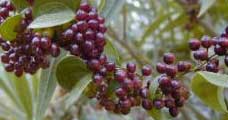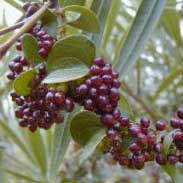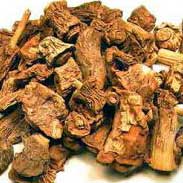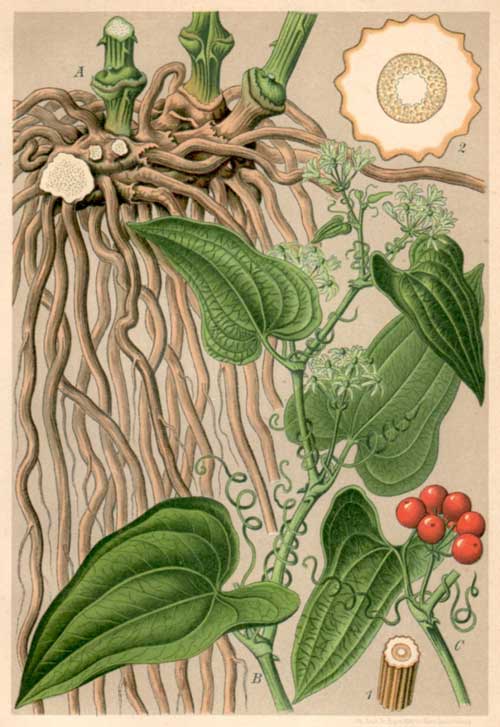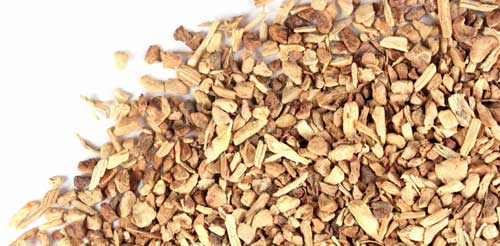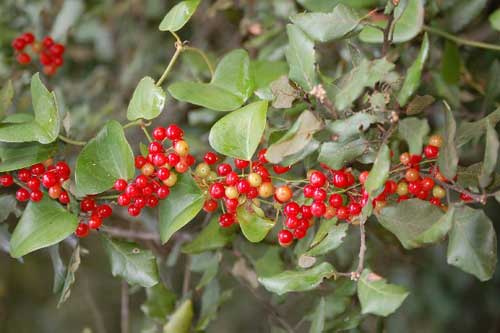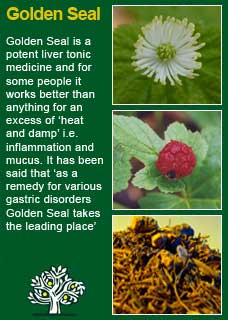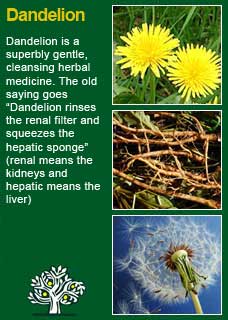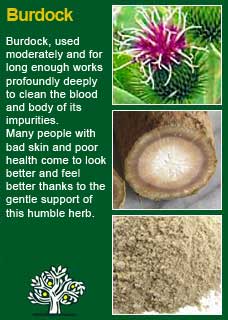
|
|
||||
| Our Pages ABOUT CONSTITUTIONAL MEDICINE
|
The root of the Sarsaparilla plant is the part used in herbal medicine. Sarsaparilla itself is a long-lived climbing vine with prickly stems. Sarsaparilla is odourless but it has a distinct acridity and slightly bitter taste that is not unpleasant in itself. It is still used as a flavouring base for soft drinks in many parts of the world and Sarsaparilla drinks were once very popular in American culture in the form of root beers.
Sarsaparilla’s most enduring recommendations have been for rheumatism and psoriasis. Given these are famously hard health problems to get better from it shows how high is the regard held for this herb that it is still widely used around the world for these problems to this very day. The ancient Greeks and Romans linked European Sarsaparilla to the treatment of poisons but when the Spanish explorers discovered the Caribbean species (a prickly; zarza, vine; parra, that was little; illa) that it was called 'Sarsaparilla' and went on to become an extremely popular medicine for many centuries. T. Bartram calls Sarsaparilla a powerful blood tonic, anti-inflammatory and anti-rheumatic and goes on to list its potential benefits for rheumatism, gout, chronic skin eruptions, psoriasis and eczema. In 1494 an unusually violent epidemic of syphilis swept through Europe and for a long time Sarsaparilla was the main treatment used for this deadly disease. Nicholas Culpeper called Sarsaparilla the best treatment for the French disease (the English name for syphilis) and also recommended it for 'eye problems, head colds, gas pains, pimples and all manner of aches in the sinews or joints'. Natives of the Amazon area have traditionally used Sarsaparilla to re-establish virility in men and to treat the symptoms of the menopause in women. These kinds of uses can be understood given the high level of steroidal saponins in the plant which will have at least some effects on human hormones. Native Americans used Sarsaparilla to treat skin problems, urinary complaints and as a tonic. The Penobscot, Ojubwas and Kwakiutl tribes of North America used Sarsaparilla as a cough remedy and the smoke of Sarsaparilla was inhaled by asthmatic patients. King's Dispensatory writes 'Sarsaparilla is generally considered as a blood cleansing alterative though stated by some to possess diuretic, diaphoretic, and emetic properties. Its mode of action, however, is not well understood... No medicine has, probably, ever passed through so many changes of popularity having been at various times most highly lauded as an efficient alterative, and as often been pronounced inert. There is no doubt, however, that, when properly prepared, it exerts a favourable influence over the system. It has been used in several chronic diseases as of the skin, as herpes, rheumatic affections, passive general dropsy, gonorrhoeal rheumatism, and other conditions of the system where an alterative is required'
~ Rudolph Weiss talks about the use of Sarsaparilla for psoriasis. He says there is reliable evidence that saponin-rich drugs have a beneficial effect on persistent psoriasis and that Sarsaparilla has the highest saponin concentration of all medicinal plants with the steroidal saponins sarsaparilloside, smilasaponin and pairllin believed to be primarily responsible for the medicinal action of Sarsaparilla root (Weiss R, Fintelmann V; Herbal Medicine, (2)300-301,1999) ~ Sarsaparilla has been popular among athletes and body-builders as a kind of natural anabolic steroid but studies reviewing all the clinical trials published showed that there was no evidence to show that the saponins that were used from the Sarsaparilla (diosgenin, smilagenin and hecogenin) increased growth hormone release in the body (Barron RL, Vanscoy GJ: Ann Pharmacother 27(5):607-615,1993) ~ Sarsaparilla was extensively studied as a treatment for psoriasis in the early 20th century prior to the development of many of the steroidal type drugs in common use today. The studies were not nearly as rigorously constructed as modern trials but they show some compelling evidence nevertheless -- which is especially persuasive given how difficult it is to successfully treat psoriasis. 2-3 months of treatment were commonly required but over 50% of the people suffering from psoriasis improved when given large daily doses of Sarsaparilla extracts, the patients who received the most benefit had chronic plaque psoriasis (Thurman FM: N Engl J Med 227:128-133,1942) ~ Sarsaparilla extracts have been observed to have anti-tubercle bacillus activity in culture studies and water extracts of Sarsaparilla have been shown to inhibit three common skin fungi (dermatophytes) called Epidermophyton floccusum, Microsporum canis and Trichophyton mentagrophytes (Caceres A et al: J Ethnopharmacol 31(3):263-276,1991) ~ The authors, titles and the 'where-and-when' published of over 20 further studies and articles on Sarsparilla are listed in a PDF found here
There are no real safety concerns however, Sarsaparilla has been such a widely used and popular herb that we can be confident that there has been ample opportunity to develop cautions in its use if they were necessary.
For some years now, against this proven and safe way of herbalism, there has been a rising tide of excessive caution and scare-mongering in many parts of the world. The same authorities that, not so long ago, decried herbal medicines as ineffectual, have now taken up a different adversarial position; that they are dangerous substances that should only be prescribed by Doctors, who of course have zero training in them. Unfortunately, the same unnecessary fear and worry has crept into many natural health websites and popular publications on herbs. Herbs that we have safely used for thousands of years, that have no reports of adverse reactions in the medical literature despite widespread use by millions of people, are suddenly described as contraindicated because of something that should have been seen as completely unimportant, or at the utmost a merely theoretical concern, such as a laboratory study on one of the herb's constituents to use an all too common example. I wonder sometimes if the writers of such articles feel that the herb will be more deserving of respect if it is thought to be a little bit dangerous, in other words more like a drug than something that has simply come out of the earth and been used by ordinary people for generations beyond count. There is just so much misinformation about herbal medicine on the internet now. Ludicrous claims and cautions abound in equal measure; it seems like one group are trying to make money out of the public whilst the other are busily trying to scare them off. I have to believe that the kind of reader who takes the time to read pages on herbs that are as extensive as this one is much less likely to be swayed by marketers or misinformers. I hope that you will keep your wits about you if you get conflicting opinions from people who have never really got to know these herbs, who have never worked with them, or learned how to use them safely and effectively. I want to remind you that the reason that herbs can never be patented and owned by any individual or corporation is because they are, and always will be, the People's medicine. They belong to all of us and it is my great hope in sharing this work that you will learn how to use them wisely for yourself, and the people you care for. Be safe, but do not be afraid.
Sarsaparilla is an intriguing herb. Looking at what kinds of serious problems it has been traditionally used to help it sounds like it should be powerful, and therefore possibly a little dangerous, but in reality Sarsaparilla is a gentle and very safe medicine that can safely be taken over extended time periods by any age group. If I were to summarise my own thoughts about Sarsaparilla, it would be to say that I feel like it is a kind of hormonal alterative. A medicine that helps deep-set conditions where there is some hormonal imbalance involved and which can benefit from cleansing. I think that the comments made over a hundred years ago in Kings Dispensatory (quoted further above) are just as true today as they were then, that 'no medicine has, probably, ever passed through so many changes of popularity having been at various times most highly lauded as an efficient alterative, and as often been pronounced inert. and I think the reason for this comes back to its hormonal action' that a person either needs that kinds of influence or they don't, so it works, or it doesn't. As there is so much we don't know about how it might work hormonally, this obviously makes it a bit hit or miss, but if you who are reading this are studying herbal medicine or want to understand more about this remedy for your own reasons then there may be a way to get around this by learning more about the ancient art of pulse testing, a simple but powerful way to ask the intuitive intelligence of the body for its responses to a herb by feeling the pulse whilst giving a tiny dose by mouth, more here In order to do that, I warmly encourage you to get a hold of some Sarsaparilla root or ready-made tincture and then, with a quiet and attentive mind, take a dose of it to see how it makes you feel. You may or may not like the flavour, but I can assure you that nothing bad will happen, rather I think there is an excellent chance that trying this old 'experiential' way of learning will give you a greater appreciation for the gentle strength of this herb than any amount of academic study of it. In my own practice I have used much of it in longer-term treatment programs for chronic conditions in the skin or the joints but in terms of dosage it may be necessary to use quite large amounts to shift a bad case of adult acne, or psoriasis, or a rheumatic inflammation in the joint that is being caused by an imbalance in the immune system. Here, the use of a tea can be economic and effective and amounts of 10 grams a day can be taken by decoction for at least a few weeks with confidence to see if it may be showing clear signs of benefit. This equates to approximately 3 heaped tsps of the drred herb, gently simmered in water for a good 15 minutes to extract its active constituents. For longer term treatments, many people find it easier to sustain the use of a tincture and here a good 5 mls or so a day may be enough to see some sustained therapeutic effects. Many herbs work well in much more moderate doses but I think Sarsaparilla needs to be used in some quantity to be confident of its effects, even then, I think there needs to be an approach of 'try and see' over a month or two, rather than continual use without clear benefit. That said, like all true gentle tonics and alterative (cleansing herbs) the longer it is taken the better it works. Sarsaparilla combines beautifully with Echinacea and Golden Seal (this particular combo was one of the old herbal physician’s classic treatment for particularly nasty infections). Sarsaparilla also combines potently with Dandelion root and Burdock root and I have personally seen many stuck and chronic conditions start to shift with these particular herbs in combination.
Much of the information here about the traditional uses of Sarsaparilla is consistent with the model of thinking whereby one may treat problem A with plant B. There is value in this approach, especially in how it helps us pass on useful knowledge to one another, but it falls short in one vital area; and that is that people are not all cut from the same cloth! Something that works brilliantly for one person may do less for another -- why is this? Part of the reason is that people vary in their constitutions as to whether they are either hotter or cooler and, at the same time, either dryer or damper. This useful and rather fascinating subject is introduced further here Another big part of using the right herb when it is most needed comes from understanding the need to treat what is going wrong for the person that had led up to their getting a health condition. In this light, Sarsaparilla can particularly offer its benefits when a cleansing action is needed in the 'cycle of healing', more about this here
Please understand that I cannot advise you, including on products or dosage, without seeing you in person in my clinic but for ideas
on how you might find a good herbalist in your area read here |
|
|
© 2011 R.J.Whelan Ltd
